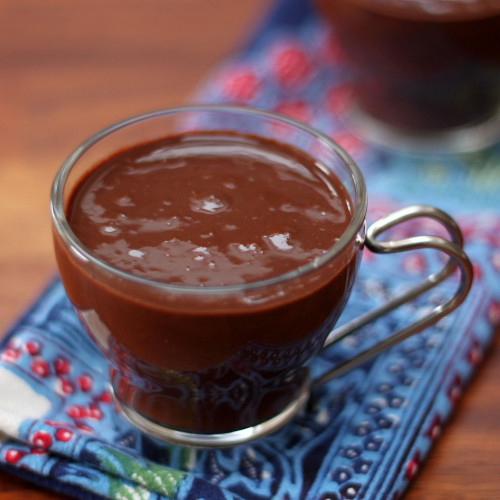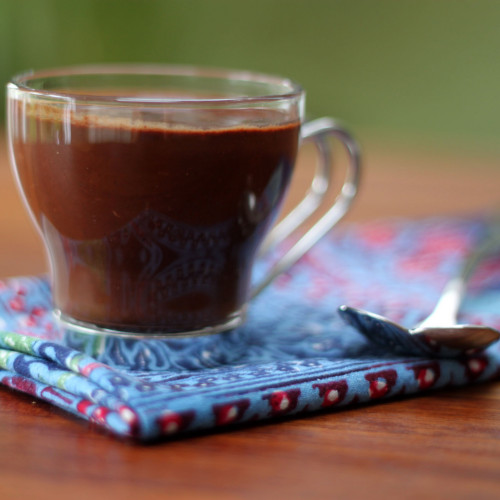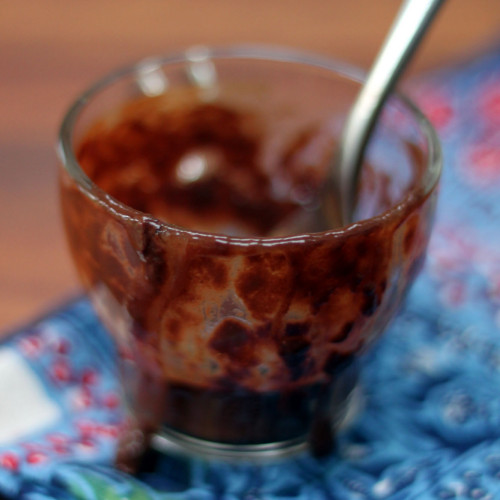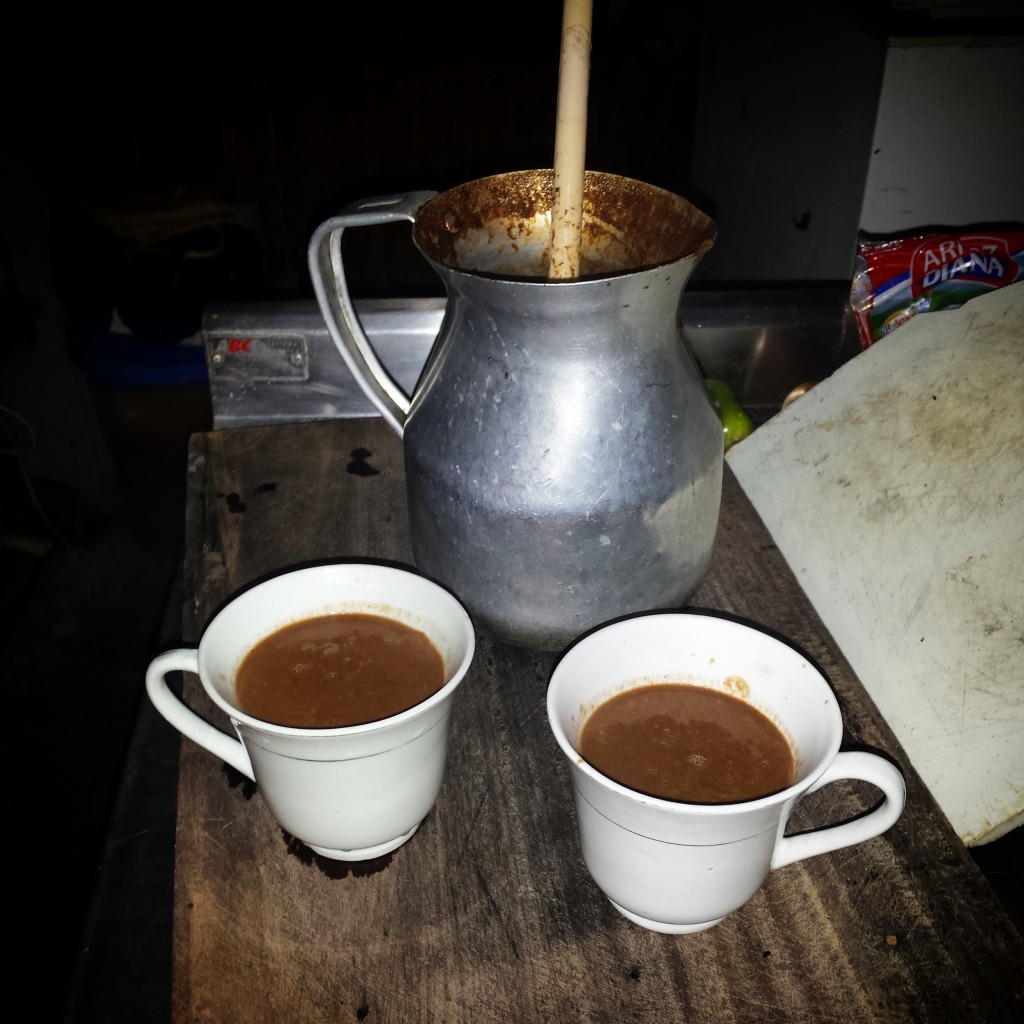In two of my final year nutrition modules, I learned about the Kuna Indians from the San Blas Islands, Panama. They have a very high consumption of cocoa and a very low incidence of cardiovascular disease. Dark chocolate has been given many health claims about its high content of flavonoids and their role in the reduction of cardiovascular disease. The Kuna Indians have exceptional cardiovascular health, which scientists believe may come from their particularly high consumption of cocoa. They drink three to four cups of cocoa per day, a similar habit to some of us Brits and our regular tea consumption, or Americans and their coffee!

While I was learning about the Kuna Indians at university, I remembered a Kuna Indian Hot Chocolate recipe that I read on The more than occasional baker‘s blog, from which this recipe is adapted. I researched further and found this interesting news clip with a few more details on the cocoa drink of the Kunas. I was fascinated by this recipe and decided that I simply must try it out for myself!

Kuna Indian Hot Chocolate
(adapted from The more than occasional baker)
1 banana
400ml water
60g cocoa (preferably not Dutch-processed, since this removes all of those health-promoting flavonoids!)
1 pinch cayenne pepper
1 pinch mixed spice
Break up the banana and boil with the water for 10 minutes on a medium heat. Use a spoon and then a whisk to break up the banana and then add the cocoa. Boil for a further 5 minutes and flavour with chilli and spices according to one’s taste. Enjoy!

As someone who prefers things on the bitter side, I found this simple concoction absolutely delicious! It tastes very different from the standard hot chocolate that we are accustomed to, which is full of milk and sugar. This Kuna Indian hot chocolate has bitter, toasty and earthy notes which are smoothed over by the soft and slightly sweet caramel notes from the banana. The spices add an extra dimension making it something very intriguing indeed. The drink has a somewhat thick consistency, similar to that of Spanish hot chocolate (chocolate caliente).
I had the pleasure of visiting the San Blas Islands in December 2014. Although I had the most incredible time with the Kuna Indians on their beautiful islands, unfortunately, I did not find their cacao drink. I did, however, find a new Colombian friend to make it with it Capurgana, Northern Colombia.

I think that this recipe would be the perfect ending to a dinner party – definitely something, with which, to enchant your diners!
Have you tried this with ripe plantains? I recall plantains being a staple in the Kuna diet so suspect that is what they would have used.
I just watched the video on Nutritionfacts.org about the Kuna Indians, their stunning low rates of heart disease, and the reason why seen as the fact that they drink 3-4 cups of cocoa a day. I knew that I had to find a recipe and try it. Hot chocolate is already one of the few beverages I enjoy. Thank you so much for providing this website and recipe!
Where can I buy this cacao or cocoa? Is it in a powered form ?
You can use any cocoa you like! I just used a commercially available cocoa powder in this particular recipe.
Hi,
Interested in the recipe and its health benefits. Just a question, you mentioned 60g of cocoa. Is that cocoa powder or cocoa beans?
Because to get cocoa powder is quite expensive but raw beans I have (we have a cocoa farm)
For this recipe I used cocoa powder but the Kuna Indians would have used roasted and ground cocoa beans 🙂
Hi Hazel, they in fact dont used roasted beans, the very reason the health benefits of non cooked beans remains.
Great website, and great recipe, thank you
I Lived On Island Of CARTI SUGDUB
(Crab Island) 1981-83 and served the 3 island still that made up the group. I Teamed with Father Louis and stayed with him along with my nurse/translator. Drank gallons of Jungle Coco and two types of Indian Beer, CHICHA LA MAZE & FRESCO.
My experience with Kuna STYLE Coco was with dried coco beans, dried toasted over an open fire. Beans could be ground or crushed then boiled in water that was brought 10-15 miles by dugouts paddled by the women of tribe and valued due it being very labor intensive to obtain potable water. Added to was gray almost slimy raw
cane sugar all boiled together till thickened. Seasoning was left to the taste of the family.
Coffee beans were purchased from passing boats heading north to Panama City Of Colon Beans were roasted over a live flame and crushed by a rock when cooled. Again beans were boiled at about 5-7 lbs in large galvanized twenty gal. Washtubs boiled over days till it became thick like coco. One canteen cup during morning rounds and sickcall gave you mild buzz just like their Coco.
CHICHA was more interesting and Had consumed a few cups of this product before I knew how it was made. Start with about 5 lbs of PRE;MASTICATED dried local grown corn for La Maze or assorted fruits dry or about to rot. Dry Ingredients like corn or fruit is chewd the especterated on a medium metal plate as saliva and now wet chewed ingredients mix with raw sugarcane.
It is all collected in crockery sealed and buried in the cool earth of the jungle from months of almost 2 YEARS. CHECHA LAMAZE Taste just like the Breakfast Cereal
“SUGAR CORN POPS” Sometimes the old Cullendaro (Medicine man) would fortify the drink with rum to thin it out.
Best 3 yrs. Of My Life As An Army Medical Corps Officer
Hi William,
Thanks so much for your comment. Fascinating to read about your experience living on the islands with the Kunas and to taste all these local culinary creations! I would absolutely love to return one day and find an island that still makes the cocoa drink, and maybe some of the other drinks you mentioned. Thank you for taking the time to share you story!
According to Google, 60 g of cocoa powder equals 34 teaspoons. Is that really what you add to 400 mils of water?
Hi Bonnie. Yes, indeed 60g is correct. This makes and intense, rich and thick hot chocolate.